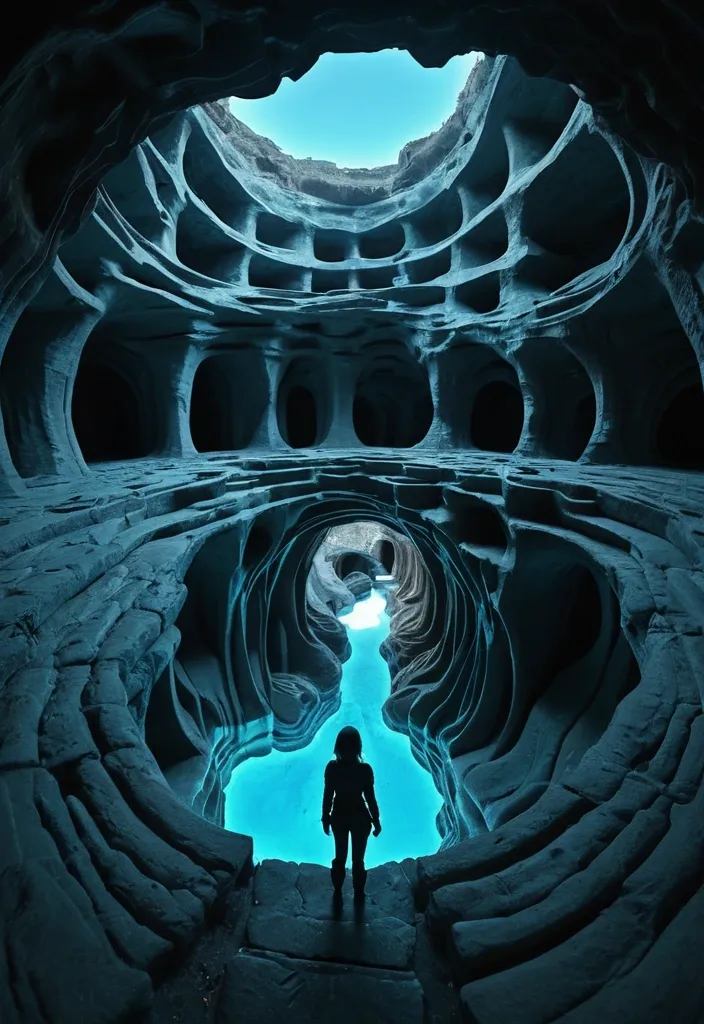Search Results for roof
Explore AI generated designs, images, art and prompts by top community artists and designers.

A striking scene on a rooftop multiple versions of Africans woman , each an embodiment of confidence and elegance , are captured under a moody , rain-soaked atmosphere. The dark lighting casts dramatic shadows , emphasizing their wet , platinum black hair glistening with raindrops. They're adorned in sleek , transparent plexiglass raincoats that reflect the shimmering Uptown , creating a mesmerizing interplay of light and water. Each woman stands in dancing poses in moments of thoughtful contemplation—while the rain cascades around them , blurring the lines between reality and dream. This scene would thrive in a high-Funktion editorial style , emphasizing raw energy and emotion. ,

Shot with panorama lens. A surreal Melting from a 3D Maze cylinder , Vertigo Art style , lone women explorer stands on the edge of a stone caves , gazing down at a sprawling caves ancient are numbered from right to left , except for the later discovered cave 29 , located high above Cave 21 of the Under-dark below , now partially reconstructed and overgrown with vibrant , alien trees. The Ajanta Caves panorama , rock-cut Buddhist cave monuments dating from the second century BCE to about 480 CE in Aurangabad district of Maharashtra state in India , Also , cave 30 is located between caves 15 and 16 , nearer the river bed (cave invisible here). Chaitanya halls are boxed , and minor caves are indicated by a smaller type. The low roofs of the cave ceiling shut out any life from the waterfall above , creating a sense of imbalance and disorientation. ,

Shot with a fish-eye lens. A surreal Melting from a 3D Maze cylinder , Vertigo Art style , lone women explorer stands on the edge of a stone-cave , gazing down at a sprawling ancient cave city carved into the walls and ceiling of cramped and short caverns of the Under-dark below , now partially reconstructed and overgrown with vibrant , alien trees. The buildings in a tranquil , blue glow , this stunning interior resembles a natural cave retreat , complete with smooth , flowing rock formations that create an organic ambiance. The low roofs of the cave ceiling shut out any life from the world above , creating a sense of imbalance and disorientation. ,

A vast ancient Eastern immortal cultivation sect hidden among towering mountain ranges covered in dense swirling mist. Endless temple complexes , pagodas , floating pavilions , spiritual towers , and skybridges stretch across the landscape , some built into the sheer cliffs , others suspended above abyssal clouds. The architecture is grand , weathered , and majestic—immense stone stairways , carved dragon pillars , curved roofs , and glowing talismans. Clusters of lanterns glow warmly through the fog , illuminating runic spiritual symbols drifting like fireflies. Giant statues of ancient sages and celestial beasts emerge faintly from the mist. Ethereal qi flows in streams throughout the scene , creating a sense of ancient power. A storm brews in the heavens—dark clouds swirling violently. Lightning crackles across the sky , dramatic bolts illuminating the vast sect and revealing hidden floating mountains and immortal palaces in the distance. Small flying boats , disciples in flowing robes , and spiritual beasts can be seen as silhouettes moving through the fog. Wide cinematic composition , ultra-detailed environment , sweeping aerial view , high-fantasy atmosphere. Hyper-realistic lighting , ancient mystical mood , breathtaking scale. ,

A surreal 3D isometric Mediterranean Coastal village clinging to a cliff-side and landmarks are made entirely from lego style. with terracotta roofs glowing under the warm , setting sun. Narrow , winding stone paths lead down to a tranquil harbor where small fishing boats are moored , tourist couple enjoy. Christmas trees over whitewashed walls , and lanterns begin to cast a soft , inviting light. A cobblestone path winds through the village is populated with LEGO figures. ,

A breathtaking low wide-angle , photorealistic 8K ultra-high-definition cinematic photograph of an incredibly beautiful Korean woman. Her face radiates genuine joy , illuminated by a warm , bright smile that brings life to the scene. Her most striking features are her clear , expressive blue eyes , sparkling with delight and reflecting the soft daylight. She is elegantly dressed in a meticulously detailed , vibrant traditional Joseon Dynasty Hanbok , showcasing its rich textures and refined colors. The setting is an authentic and beautifully preserved Korean Hanok village or courtyard , featuring traditional wooden architecture with elegant tiled roofs and lush , serene greenery in the background , all bathed in abundant , soft natural daylight. The composition is captured from a low wide-angle perspective , emphasizing her graceful and joyful presence against the tranquil , historical Hanok scenery. The lighting is natural and luminous , subtly highlighting her flawless skin and the intricate details of her Hanbok. This image captures a moment of pure , vibrant happiness , blending traditional Korean aesthetics with cinematic photographic quality. ,

A captivating artistic rendering , like a classical Korean painting or a master's oil portrait , of an incredibly beautiful Korean woman. Her face , pure and delicate , is gently kissed by a bright , warm light that casts a soft , inviting glow upon her forehead and cheeks , imbuing her with a tender radiance. Her expression carries a blend of ethereal innocence , a touch of gentle vulnerability , and a subtly captivating charm that emanates from her deep , soulful eyes. She is elegantly dressed in a meticulously detailed traditional Joseon Dynasty Hanbok , adorned with soft , refined colors , and gracefully holds a classic Korean flute (피리) in her hands. The setting is an authentic Joseon Dynasty street scene , featuring quaint traditional wooden buildings with tiled roofs and perhaps a subtle hint of everyday life in the background , all bathed in a warm , diffused daylight. The composition is captured from a low wide-angle perspective , emphasizing her dignified yet gently vulnerable presence against the intricate historical cityscape. The art style should evoke the timeless beauty of traditional Korean aesthetics combined with classical painting techniques , using a gentle and warm color palette and delicate brushstrokes to create a scene of poetic tranquility and serene , yet alluring , beauty. ,

9:16 ratio. Hyperrealism. Full-length , breathtakingly beautiful , alluring young woman with long , sturdy legs. She is dressed in tight , navy-colored , sleeveless , full-body leggings with a fitted baby-pink colored zipper-style vest , complete with normal jewelry , a thin string gold necklace , and a pair of black sandal heels. Behind her , the background features Gothic palaces with domestically styled roofs. The air is filled with clear and bright sunlight , and in the distance , you can see the magnificent palace roofs and the harmonious buildings of colorful spires. Movie-like scene production , dramatic shadows , delicate skin expression , ultra-high definition 8K , clear focus , and depth of field. ,

A figure made of colored painted resin. Full-length , breathtakingly beautiful , alluring young woman with long , sturdy legs. She is dressed in a regal , Korean-inspired tennis outfit , complete with a necklace , and an embellished baby pink sports top with white skirts. Behind her , in autumn , with a visible palace. A tennis court filled with clear and bright sunlight , and in the distance , you can see the magnificent palace roofs and the harmonious buildings of colorful dancheong. Movie-like scene production , dramatic shadows , delicate skin expression , ultra-high definition 8K , clear focus , and depth of field. ,

Edo , 17th-century capital of the Tokugawa Shogunate , wooden bridges spanning wide canals , tiled-roof houses and distant castle keep , cherry trees blooming under clear spring sky , midday , Style: Matte Painting , detailed and atmospheric with subtle depth of field , Wide view , Side View , 4K. ,

"A strong , imposing figure stands on a rooftop , back to the viewer , gazing intently at the moon. The scene is rendered in a graphic novel style , with bold lines and dramatic shadows. He has his hands in his pockets , dressed in casual evening wear. His dark skin is subtly illuminated by the city lights below , hinting at his muscular build. His dreadlocks are visible even in silhouette , cascading down his back. His entire posture conveys a sense of longing and contemplation directed solely at the moon above. The city lights twinkle below , but his undivided attention is fixed on the lunar orb , which casts a soft glow on his back. The overall color palette is rich and saturated , with deep blues , purples , and reds dominating , creating a sense of solitude and longing. His piercing eyes , though unseen , possess a wolf-like coloration , adding to his imposing presence." ,

"A strong , imposing figure stands on a rooftop , back to the viewer , gazing intently at the moon. The scene is rendered in a graphic novel style , with bold lines and dramatic shadows. He has his hands in his pockets , dressed in casual evening wear. His dark skin is subtly illuminated by the city lights below , hinting at his muscular build. His dreadlocks are visible even in silhouette , cascading down his back. His entire posture conveys a sense of longing and contemplation directed solely at the moon above. The city lights twinkle below , but his undivided attention is fixed on the lunar orb , which casts a soft glow on his back. The overall color palette is rich and saturated , with deep blues , purples , and reds dominating , creating a sense of solitude and longing. His piercing eyes , though unseen , possess a wolf-like coloration , adding to his imposing presence." ,

"A strong , imposing figure stands on a rooftop , back to the viewer , gazing intently at the moon. The scene is rendered in a graphic novel style , with bold lines and dramatic shadows. He has his hands in his pockets , dressed in casual evening wear. His dark skin is subtly illuminated by the city lights below , hinting at his muscular build. His dreadlocks are visible even in silhouette , cascading down his back. His entire posture conveys a sense of longing and contemplation directed solely at the moon above. The city lights twinkle below , but his undivided attention is fixed on the lunar orb , which casts a soft glow on his back. The overall color palette is rich and saturated , with deep blues , purples , and reds dominating , creating a sense of solitude and longing. His piercing eyes , though unseen , possess a wolf-like coloration , adding to his imposing presence." ,

"A strong , imposing figure stands on a rooftop , back to the viewer , silhouetted against the night sky. The scene is rendered in a graphic novel style , with bold lines and dramatic shadows. He has his hands in his pockets , dressed in casual evening wear. His dark skin is subtly illuminated by the city lights below , hinting at his muscular build. His dreadlocks are visible even in silhouette , cascading down his back. The city lights twinkle below , but his attention is focused on the moon above , which casts a soft glow on his back. The overall color palette is rich and saturated , with deep blues , purples , and reds dominating , creating a sense of solitude and longing. His piercing eyes , though unseen , possess a wolf-like coloration , adding to his imposing presence." ,

"A strong , imposing figure stands on a rooftop , back to the viewer , silhouetted against the night sky. The scene is rendered in a graphic novel style , with bold lines and dramatic shadows. He has his hands in his pockets , dressed in casual evening wear. His dark skin is subtly illuminated by the city lights below , hinting at his muscular build. His dreadlocks are visible even in silhouette , cascading down his back. The city lights twinkle below , but his attention is focused on the moon above , which casts a soft glow on his back. The overall color palette is rich and saturated , with deep blues , purples , and reds dominating , creating a sense of solitude and longing. His piercing eyes , though unseen , possess a wolf-like coloration , adding to his imposing presence." ,

"A strong , imposing figure stands on a rooftop , back to the viewer , silhouetted against the night sky. The scene is rendered in a graphic novel style , with bold lines and dramatic shadows. He has his hands in his pockets , dressed in casual evening wear. His dark skin is subtly illuminated by the city lights below , hinting at his muscular build. His dreadlocks are visible even in silhouette , cascading down his back. The city lights twinkle below , but his attention is focused on the moon above , which casts a soft glow on his back. The overall color palette is rich and saturated , with deep blues , purples , and reds dominating , creating a sense of solitude and longing. His piercing eyes , though unseen , possess a wolf-like coloration , adding to his imposing presence." ,

"A strong , imposing figure stands on a rooftop , back to the viewer , silhouetted against the night sky. The scene is rendered in a graphic novel style , with bold lines and dramatic shadows. He has his hands in his pockets , dressed in casual evening wear. The city lights twinkle below , but his attention is focused on the moon above , which casts a soft glow on his back. The overall color palette is rich and saturated , with deep blues , purples , and reds dominating , creating a sense of solitude and longing." ,

https://arthub.ai/post/22000d7f-3773-4fe9-a2a4-b98acd77fbcf Artstation , Illustration , Graphic Novel , A strong , imposing figure stands on a rooftop , silhouetted against the night sky. The scene is rendered in a graphic novel style , with bold lines and dramatic shadows. He has his hands in his pockets , dressed in casual evening wear. The city lights twinkle below , but his attention is focused on the moon above. The overall color palette is rich and saturated , with deep blues , purples , and reds dominating , creating a sense of solitude and longing. , "Forte , elegante e imponente (Strong , elegant , and imposing) , he exudes an aura of power and control. He appears to be in his late 20s to early 30s , with dark skin , dreadlocks , and piercing eyes that possess a wolf-like coloration. His gaze is intense and unwavering , hinting at the wildness that lies beneath his composed exterior. He carries himself with the posture of an alpha , his shoulders squared , his movements deliberate and purposeful. He is a protector , a provider , and a figure who commands respect through his strength and quiet authority." ,

https://arthub.ai/post/22000d7f-3773-4fe9-a2a4-b98acd77fbcf Artstation , Illustration , Graphic Novel , A strong , imposing figure stands on a rooftop , silhouetted against the night sky. The scene is rendered in a graphic novel style , with bold lines and dramatic shadows. He has his hands in his pockets , dressed in casual evening wear. The city lights twinkle below , but his attention is focused on the moon above. The overall color palette is rich and saturated , with deep blues , purples , and reds dominating , creating a sense of solitude and longing. , "Forte , elegante e imponente (Strong , elegant , and imposing) , he exudes an aura of power and control. He appears to be in his late 20s to early 30s , with dark skin , dreadlocks , and piercing eyes that possess a wolf-like coloration. His gaze is intense and unwavering , hinting at the wildness that lies beneath his composed exterior. He carries himself with the posture of an alpha , his shoulders squared , his movements deliberate and purposeful. He is a protector , a provider , and a figure who commands respect through his strength and quiet authority." ,

https://arthub.ai/post/22000d7f-3773-4fe9-a2a4-b98acd77fbcf Artstation , Illustration , Graphic Novel , A strong , imposing figure stands on a rooftop , silhouetted against the night sky. The scene is rendered in a graphic novel style , with bold lines and dramatic shadows. He has his hands in his pockets , dressed in casual evening wear. The city lights twinkle below , but his attention is focused on the moon above. The overall color palette is rich and saturated , with deep blues , purples , and reds dominating , creating a sense of solitude and longing. , "Forte , elegante e imponente (Strong , elegant , and imposing) , he exudes an aura of power and control. He appears to be in his late 20s to early 30s , with dark skin , dreadlocks , and piercing eyes that possess a wolf-like coloration. His gaze is intense and unwavering , hinting at the wildness that lies beneath his composed exterior. He carries himself with the posture of an alpha , his shoulders squared , his movements deliberate and purposeful. He is a protector , a provider , and a figure who commands respect through his strength and quiet authority." ,

Artstation , Illustration , Graphic Novel , "Esbelta , elegante e graciosa (Slender , elegant , and graceful) , she possesses a timeless beauty that belies her true age. She appears to be in her late 20s to early 30s , with dark skin , long dark dreadlocks , and striking eyes that hold a captivating allure. Her eyes have a subtle reddish hue , a telltale sign of her vampiric nature , adding to her mystique. She carries herself with a quiet confidence and an air of sophistication , reflecting her long life and vast experiences. Her movements are fluid and graceful , like a dancer , and her presence commands attention without demanding it." , A panel showing a stylized tidal wave crashing over a city skyline. She is standing on a rooftop , her arms outstretched , as the wave of memories washes over her , her expression a mixture of joy and sorrow. ,

Artstation , Illustration , Graphic Novel , "Esbelta , elegante e graciosa (Slender , elegant , and graceful) , she possesses a timeless beauty that belies her true age. She appears to be in her late 20s to early 30s , with dark skin , long dark dreadlocks , and striking eyes that hold a captivating allure. Her eyes have a subtle reddish hue , a telltale sign of her vampiric nature , adding to her mystique. She carries herself with a quiet confidence and an air of sophistication , reflecting her long life and vast experiences. Her movements are fluid and graceful , like a dancer , and her presence commands attention without demanding it." , A panel showing a stylized tidal wave crashing over a city skyline. She is standing on a rooftop , her arms outstretched , as the wave of memories washes over her , her expression a mixture of joy and sorrow. ,

Artstation , Illustration , Graphic Novel , "Esbelta , elegante e graciosa (Slender , elegant , and graceful) , she possesses a timeless beauty that belies her true age. She appears to be in her late 20s to early 30s , with dark skin , long dark dreadlocks , and striking eyes that hold a captivating allure. Her eyes have a subtle reddish hue , a telltale sign of her vampiric nature , adding to her mystique. She carries herself with a quiet confidence and an air of sophistication , reflecting her long life and vast experiences. Her movements are fluid and graceful , like a dancer , and her presence commands attention without demanding it." , A panel showing a stylized tidal wave crashing over a city skyline. She is standing on a rooftop , her arms outstretched , as the wave of memories washes over her , her expression a mixture of joy and sorrow. ,

Artstation , Drawing , Graphite , Charcoal Art , "He is a man of imposing presence , his immortality etched subtly into his ageless features. His dark skin is weathered but strong , hinting at a life lived long and hard. His dreadlocks , like hers , are styled in a way that blends tradition with a modern edge. His eyes , with their striking wolf-like coloration , possess a piercing intensity that can be both captivating and unnerving. His gaze is direct and unwavering , conveying a sense of control and hidden danger. He carries himself with the posture of an alpha – shoulders squared , chest out , movements deliberate and purposeful. He is a figure of strength and quiet power , radiating an aura of both confidence and mystery. He might be dressed in a way that reflects his timeless nature – perhaps a well-tailored suit with a vintage flair , or rugged clothing that speaks to his connection with the natural world. Whatever he wears , it is clear that he is a force to be reckoned with – a protector , a provider , and a figure who commands respect without uttering a word." , "Illustration: A solitary scene depicting a man of imposing presence , with dark skin , dreadlocks , and striking eyes with a wolf-like coloration , standing on a rooftop overlooking a sprawling cityscape. He is gazing up at the moon , lost in thought , his expression conveying a deep sense of longing and remembrance. He holds a bottle of liquor in one hand. His eyes , though dry , reflect a profound sadness and the weight of his immortal existence. He is dressed in a way that reflects his timeless nature and his connection to the past. The overall mood is one of quiet contemplation and profound sadness. The style is evocative and atmospheric , capturing the enduring power of his love for her. The moonlight should be a key element , connecting him to her and to their shared past." ,

Here’s the **complete top-down layout and floor organization** of the Unsilenced Clocktower — integrating your new **Herbalist Greenhouse** and **Training Chamber** while keeping visual , architectural , and thematic consistency. It’s structured for easy translation into a map or illustration prompt. --- # 🕰 **The Unsilenced Clocktower – Structural Blueprint** ### **Architectural Style** Black-iron framework with brass support columns , gear-driven lifts , crystal illumination , and alchemic energy conduits linking all levels. Vertical balance: **industrial base → residential middle → arcane summit.** All spaces connected via a central spiral stair and a teleport-lift running on the Eye of Hours’ pulse. --- ## **LEVEL 1 – Ground Floor: Reception & Archives** * **Purpose:** Guild entry , civilian interface , recordkeeping. * **Design:** * Tall iron-framed doors leading to **Butler’s reception desk**. * **Civic archives** in brass filing cabinets , stamped with the seal of the Unsilenced. * Elevator cage and spiral stairs in the center. * Discreet door to **vault access** beneath the floor. * **Ambience:** Lamplit , orderly , faint hum of machinery underfoot. --- ## **LEVEL 2 – Guild Quarters & Workshop** * **Purpose:** Living space , repair , everyday operations. * **Features:** * **Workbenches** with open runic blueprints. * **Dorm alcoves** curtained with embroidered sigils for privacy. * Compact **kitchen and communal table** for late-night work sessions. * Tool racks , gears , pulleys , and mechanical prosthetics in progress. * **Lighting:** Warm brass sconces and crystal lamps. --- ## **LEVEL 3 – Training Chamber (Arcane Defense Hall)** * **Purpose:** Testing and tempering of artifacts and spells. * **Features:** * **Circular containment arena** with concentric obsidian runes. * Pivoting mirrors and magic-absorption conduits in walls. * Elevated **balcony** for observers and Orwen’s control console. * Equipment racks with enchanted weapons , armor , and focus tools. * Side alcove with **first aid and spell dampeners.** * **Lighting:** Alternating blue-white flashes , residual sparks , energy hum. --- ## **LEVEL 4 – Greenhouse Conservatory** * **Purpose:** Potioncraft , herb cultivation , magical flora study. * **Design:** * Glass dome roof with brass ribs , filled with lush plants glowing in warm mist. * **Alchemy benches** , hanging glass terrariums , and self-watering copper pipes. * Spiral stair leading to upper deck catwalks. * Containment terrarium for volatile plants under runic seals. * Connection door to the laboratory above via runic elevator. * **Lighting:** Natural light filtered through golden-tinted glass; ambient mist sparkle. --- ## **LEVEL 5 – Research Deck / Teleportation Dock** * **Purpose:** Central hub for Disc resonance studies. * **Features:** * **Resonator Table** at center (Disc analysis). * Floating quills and holographic projectors. * Side alcoves with teleport pads and sigil calibrators. * Window ring providing view of Trielta skyline. * Ladder access to observatory above. * **Lighting:** Cold white magical glow , subtle runic shimmer. --- ## **LEVEL 6 – Eye of Hours Observatory** * **Purpose:** Observation , navigation , and planar alignment. * **Design:** * Vast **crystal lens** suspended in clock-armature overhead. * Star charts , orreries , and arcane instruments scattered across floor. * A narrow catwalk circles the chamber , open to the skyline. * Viewport allows visual connection to distant ley-line convergence points. * **Lighting:** Moonlight refracted through rotating crystal , cool blues and golds. --- ### **STRUCTURAL EXTRAS** * **Vault (Sublevel):** Secure storage for Discs and relics , protected by Silence Ward. * **Exterior Balcony (adjacent to Greenhouse):** Overlooks Oldhut rooftops; used for sky readings and cooling brews. * **Hidden Lift Shaft:** connects levels 1 → 6 , running through the tower’s core , powered by Orwen’s leywheel. --- ### **Image Prompt for Top-Down Cutaway Map** > *A detailed fantasy cutaway illustration of a six-level clocktower headquarters , * blending **arcane architecture and steampunk design.** > Each level distinct: > > * reception hall (desks , ledgers , gears) , > * living workshop (bunks , tools , warmth) , > * training arena (obsidian rings , magical sparks) , > * greenhouse (glass dome , glowing plants , mist) , > * research lab (Resonator Table , runes , floating quills) , > * observatory (rotating crystal lens , starlight). > Include spiral stair and central lift through all floors. > Brass , iron , and crystal dominate the color palette; **golden light below , cool silver above.** > *Style:* semi-realistic digital painting , cinematic , highly detailed , slightly cutaway side view. ,

Bird's eye view , a clouds depicted in an Abstract graphic Interference style , with swirling lines patterns and dynamic light motion speed effects. The holographic elements should create a sense of movement and energy with a beautiful woman stands triumphantly on the roof of his F1-race car as it slowly crosses the checkered finish line. His arms are raised victoriously , and a smile. a slender figure. . Employ a black color palette of sapphire black with iridescent shimmer. Style: Celestial , ethereal , abstract , digital art black Lighting: Dramatic backlighting , bright glowing particles , contrasting dark background Composition: dynamic diagonal , composition , upward gaze Details: Sparkling gray waves and smoke , streaking white light trails , sense of movement and wonder , magical atmosphere Quality: High detail , 4K , Masterpiece , Rendered in Octane. Wide Angle View , Ultra Long Distance Wide Angle Lens ,

Threshold of a home , Normandy 1300 CE , carved stone doorway marked with protective blessings , timber beams and thatched roof , sunlight filtering through misty yard , early autumn morning , Style: hyperrealistic with a painterly texture , reminiscent of historical reconstruction art , detailed and atmospheric with subtle depth of field , Wide view , Side View , 4K. ,

Tell es-Sawwan in 4000 BCE , early Mesopotamian riverside settlement , rectangular mudbrick houses with reed roofs , defensive walls and storage pits , villagers shaping clay figurines and tending goats , irrigation channels from the Tigris River , date palms and cultivated fields nearby , tranquil yet industrious atmosphere of early agriculture and craft , morning , sunny , spring , Concept Art , 4K ,

A young woman plays the violin on a rooftop terrace high above a cityscape at dusk. She has long , flowing dark hair that billows in the wind , and she wears an ethereal , translucent white dress with soft ruffles that shimmer in the evening light. The scene is illuminated by a warm , golden sunset casting a soft glow over everything , enhancing the dreamlike quality of the moment. In the background , a sprawling city is visible , dotted with lights as they begin to twinkle like stars against the twilight sky. White feathers float around her , adding a whimsical touch. The composition features a dynamic angle from above , emphasizing both the performer and the expansive city below. The artistic style is reminiscent of anime and digital painting , characterized by its vivid colors and intricate detail. The technique employs a blend of realism and fantasy , with high contrast between the bright foreground and the darker , atmospheric background. The influence of contemporary fantasy art and anime aesthetics shines through , drawing the viewer into a serene yet awe-inspiring atmosphere. ,
